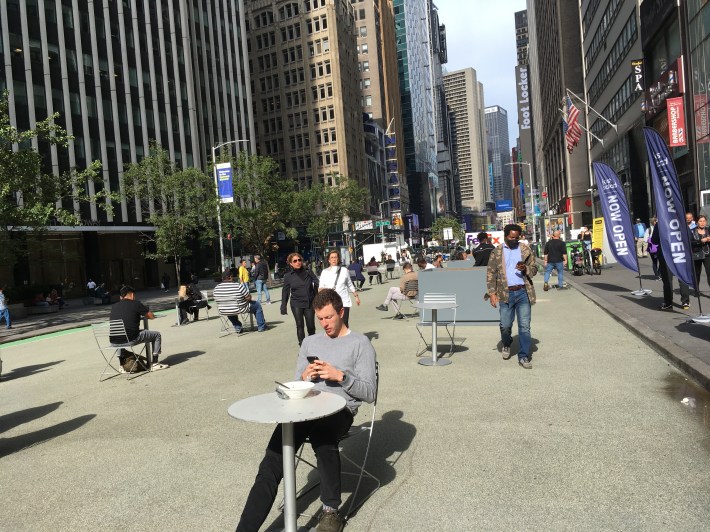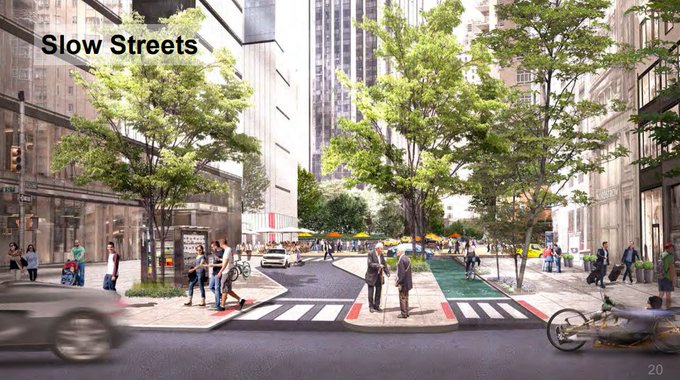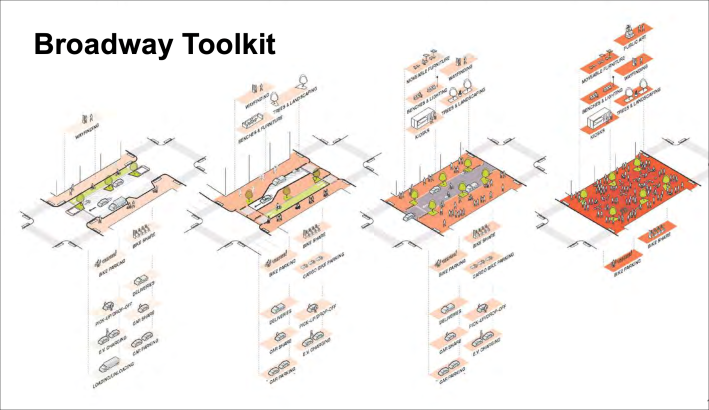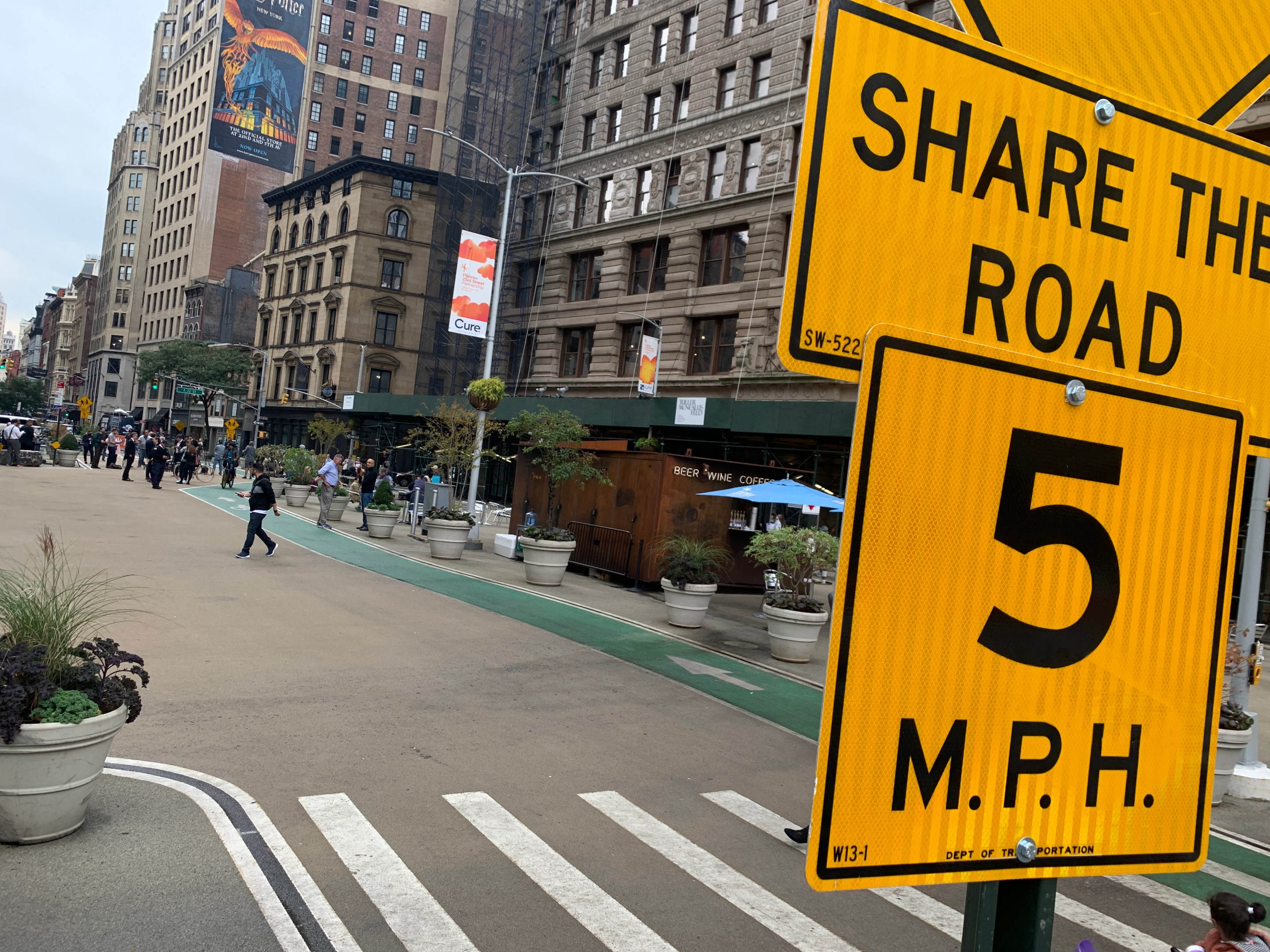Updated | Not only Broadway's theaters are getting their groove back.
A year and nine months after introducing a "toolkit" for further pedestrian improvements on Broadway, and scant weeks before the end of the de Blasio administration, the city on Monday unveiled six pedestrian-friendly blocks along New York's iconic, but still mostly car-welcoming, boulevard.
The new zones — including one car-free block between 39th and 40th streets, and five slow-street or shared-street blocks between 21st and 23rd streets, 38th and 39th streets, 48th and 50th streets — comprise half of the Department of Transportation's 12-block "Broadway Vision" project for the 2.5-mile stretch between Columbus Circle and Union Square. At a presser on Monday on the new slow-street segment in the Flatiron District, Transportation Commissioner Hank Gutman said another six blocks were on schedule for completion next year.
The shared streets feature pedestrian seating, bike lane, and s-shaped "chicanes" that are supposed to slow car traffic to 5 mph. The pedestrianized plaza does not allow drivers access at all.
The six blocks — which add to pedestrian-friendly areas of Times, Herald, Madison and Union squares installed during the Bloomberg administration — are a far cry from the vision of safe-streets activists, who have advocated for a car-free Broadway from Morningside Heights on the Upper West Side to Houston Street on the Lower East Side. They are also a long time in coming — delayed by the pandemic, but also seven years and nearly 10 months from the start of the administration that said it was keen on building on the legacy of its predecessor. Activists nonetheless hailed the expansion as they pressed for more.
“The expansion of pedestrian space on Broadway is very exciting and works to realize the full potential of transforming Manhattan’s core corridor into a people-focused place," said Katherine Nessel, co-lead of Transportation Alternatives's Car-Free Broadway campaign. "I hope the next administration builds on this progress toward a car-free Broadway and also pursues a true linear park along the avenue.”

For Gutman, however, the shared space represents a culmination. "This is a genuine sharing of the streets responsibly and safely for all New Yorkers," he said. "It's a complete re-imagining of how New Yorkers enters interact with our streetscapes."
Gutman and Mayor de Blasio, who arrived to cut a ribbon with other elected officials, credited the open-streets movement with spurring the change.
"A shared street means we focus on each other, we focus on life. Not just making everything about the vehicles around us, but more about the people around us" the mayor said. "We learned in this pandemic things that we didn't know before. And we wish we had never heard of the coronavirus, but we did learn together some ways to do things different and better."
Others, however, complained that the DOT's shared streets were much watered down from the concept that the department introduced last year (see photo below), which featured fully built-out infrastructure to ensure slow car speeds, but also keep pedestrians safe. But DOT said on Monday that such designs were merely "suggestions."

But even the reality is not immediately being received all that well. In particular, advocates complained that work-in-progress shared-street blocks of Broadway north of Times Square, between 47th and 49th streets, allow car drivers to endanger other users because the design takes away protections from the bike lane there. The DOT tweeted in response that "work is ongoing at this location. We are monitoring this shared street design and will update this and future designs as needed."
Council Member Carlina Rivera, who wrote the legislation making open streets a permanent part of the DOT's mandate, said she hoped that the department would do better. "I try to push them to envision as many streets as possible to be car free," she said. "We've been pretty unapologetic about it in saying, 'Fewer cars and more streets for people.' That's the mantra."
DOT officials were keen to show off the “toolkit” consisting of “slow blocks,” “shared streets,” "plaza blocks" and “base blocks,” displaying a board (below) that with the kit's various amenities and street configurations, among them bike parking, wayfinding, benches and lighting, kiosks, trees and landscaping, and movable furniture.

The press conference also highlighted the contribution of business improvement districts to "Broadway Vision": the Flatiron/23rd Street Partnership, the Garment District Alliance, and the Times Square Alliance. The DOT has consistently been pushed by BIDs to create better public space on Broadway and elsewhere. In January, the Union Square Partnership unveiled a $100-million plan to remove cars from the Union Square-14th Street area and create almost 100,000 more square feet of public space. This month, so-called NoMad Piazza Pop Up — which allows pedestrians and bicyclists, but prohibits car traffic other than emergency vehicles — features public seating, tables, trees, and planters in the roadbed, which will be cordoned off with granite blocks until the removal of the plaza in early November.
The DOT relies on the BIDs to perform routine cleaning, maintenance and public safety, which they do in order to promote local businesses. The plazas and other pedestrian-friendly arrangements have gained a huge following among residents, businesses and tourists and rank among the city’s most popular destinations. The partnerships are useful — but only a small, mostly wealthier, portion of the city has such entities.
Updated with information about the shared-street blocks of Times Square North.






